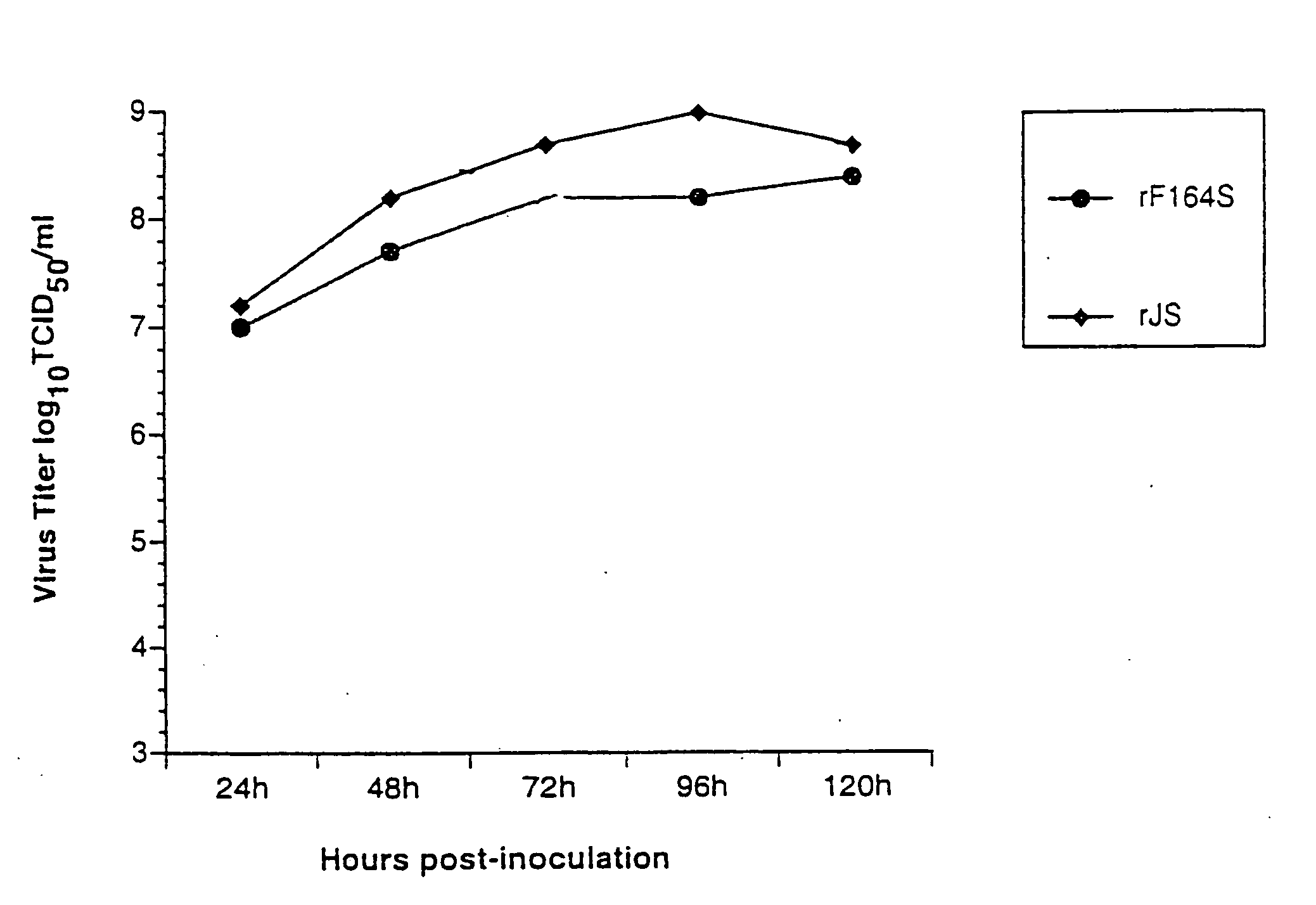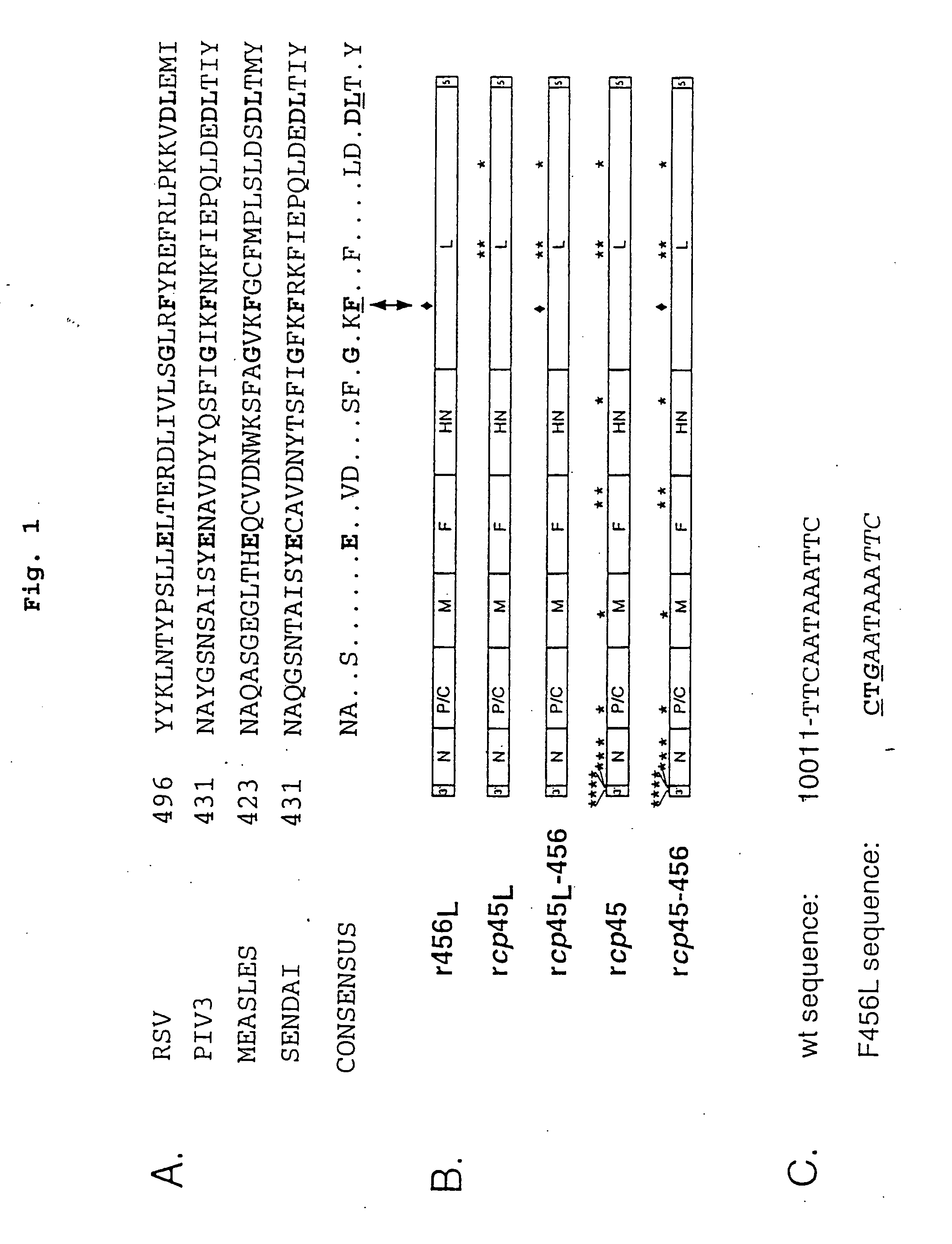Production of attenuated negative stranded RNA virus vaccines from cloned nucleotide sequences
a technology of nucleotide sequences and rna virus, which is applied in the field of production of attenuated negative stranded rna virus vaccines from cloned nucleotide sequences, can solve the problems of genetic stability of attenuated viruses, the inability to achieve an appropriate balance between attenuation and immunogenicity, and the inability to prevent severe morbidity and significant mortality
- Summary
- Abstract
- Description
- Claims
- Application Information
AI Technical Summary
Benefits of technology
Problems solved by technology
Method used
Image
Examples
example i
[0166] Mapping Attenuating Mutations Identified in HPIV3 JS cp45 and RSV cp530 and Sendai Virus to Conserved Sequence Elements Among Heterologous Negative Stranded RNA Viruses
[0167] The present example demonstrates that mutations identified in one mutant negative stranded RNA virus can be readily mapped to corresponding, conserved amino acid sequence elements in heterologous viruses within the order Mononegavirales. These mutations that are characterized by a structural change compared to a parental sequence, which parental sequence is conserved (identically or conservatively) among one or more heterologous negative stranded RNA viruses, provide likely candidate mutations for incorporation within recombinant viruses sharing the parental protein sequence elements.
[0168] To exemplify this aspect of the invention, a panel of known mutations within the HPIV3 mutant strain JS cp45 was analyzed. This panel of mutations includes ts attenuating amino acid substitutions in the polymerase L...
example ii
Heterologous Transfer of an Attenuating Mutation from RSV cpts530 L into a Recombinant HPIV3 Vaccine Candidate
[0175] Having thus identified attenuating mutations at sites that correspond to conserved structural elements between heterologous taxa within the Mononegavirales, the concept of heterologous transfer of attenuating mutations across phylogenetic boundaries was tested using the important disease virus RSV as a model. In this context, the present example demonstrates that an attenuating (att) mutation identified in RSV, a virus in the pneumovirus genus of the Paramyxoviridae family, can be transferred to PIV3, a member of the distantly-related Respirovirus genus. These viruses represent two different subfamilies within the Paramyxoviridae Family, Pneumovirinae and Paramyxovirinae, respectively.
[0176] More specifically, an attenuating mutation in a first, heterologous virus (RSV cpts530), which altered the parental RSV sequence at a defined site of mutation (Phe521 of the RS...
example iii
Heterologous Transfer of an Attenuating Mutation in the C Protein of Sendai Virus into a Recombinant HPIV3 Vaccine Candidate
[0200] The present example describes heterologous transfer of a known attenuating mutation in the C protein of Sendai virus (SeV), marked by a substitution of phenylalanine (F) to serine (S) at position 170 (Itoh et al., J. Gen. Virol. 78:3207-3215 (1997), incorporated herein by reference), to a corresponding position in a recombinant HPIV3 clone. As described above and illustrated in Table 4, The F170 parental sequence element maps to an identically conserved sequence position / residue F164 in the HPIV3 C protein, which element is also conserved in SeV and BPIV-3.
[0201] The F170S mutation of SeV was transferred to a recombinant HPIV3 virus rF164S by introduction of a point mutation into the C ORF of HPIV3, changing amino acid position 164 from phenylalanine (F) to serine (S). The resulting rF164S recombinant was surprisingly, more attenuated in the upper tha...
PUM
| Property | Measurement | Unit |
|---|---|---|
| Temperature | aaaaa | aaaaa |
| Immunogenicity | aaaaa | aaaaa |
Abstract
Description
Claims
Application Information
 Login to View More
Login to View More - R&D
- Intellectual Property
- Life Sciences
- Materials
- Tech Scout
- Unparalleled Data Quality
- Higher Quality Content
- 60% Fewer Hallucinations
Browse by: Latest US Patents, China's latest patents, Technical Efficacy Thesaurus, Application Domain, Technology Topic, Popular Technical Reports.
© 2025 PatSnap. All rights reserved.Legal|Privacy policy|Modern Slavery Act Transparency Statement|Sitemap|About US| Contact US: help@patsnap.com



